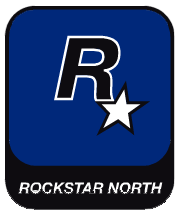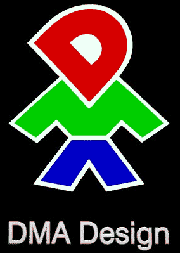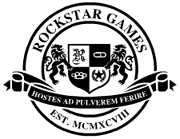For this blog I have been asked to take a look at early Japanese games and early European and American Games and look at the difference between them especially the design aspect of the early games that were being developed.
To look at old games I had to look at some old consoles. For this blog I have looked at the Atari 2600 and the Neo Geo. I will be explaining a little about each console and then looking at the different games for them.
 The Atari 2600 was first released in 1977, and it was the first successful video games console to use plug in cartridges instead of having games built in them. Some of the notable games that were released on the Atari 2600 are:
The Atari 2600 was first released in 1977, and it was the first successful video games console to use plug in cartridges instead of having games built in them. Some of the notable games that were released on the Atari 2600 are:Breakout
Combat
Donkey Kong
Kaboom
Keystone Kapers
Ms Pac-Man
Pac-Man
Pitfall
Pole Position
Real Sports Tennis
Solaris
Space Invaders
Sword Quest Series
Yars’ Revenge
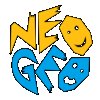
The Neo Geo was another console to use plug in cartridges. It was released in 1990 by Japanese game company SNK. It was years ahead of its time offering colourful 2D graphics and high quality sound. It was a major platform for arcade games at the time but was also available as a costly home console. There were two different versions of the system; these were known as the AES (Advanced Entertainment System) and the MUS (Multi Video System). Games for the Neo Geo included:
Nam 1975
Fatal Fury
King of the Monsters
Art of Fighting
Baseball Stars 2
Puzzle Bobble
Samurai Showdown
Sonic Wings 2
Super Sidekicks
Metal Slug
The Last Blade
Shock Troopers
Some of the games I have looked at for the Atari 2600 were Adventure, Kaboom and Pitfall
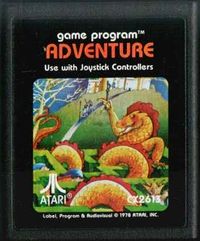 Adventure was, when first released, considered the first action adventure. It was released in1978 by Atari. Adventure was inspired by a computer text games called Colossal Cave Adventure. Atari bosses said that it could not be done but game designer Warren Robinett, created a graphic game based on a text game. Adventure went on to sell a million copies. The object of the game was to find the Chalice and return it too the Gold Castle. The character was represented by a square and would explore a multi screen landscape, which could contain castles, mazes and other various rooms.
Adventure was, when first released, considered the first action adventure. It was released in1978 by Atari. Adventure was inspired by a computer text games called Colossal Cave Adventure. Atari bosses said that it could not be done but game designer Warren Robinett, created a graphic game based on a text game. Adventure went on to sell a million copies. The object of the game was to find the Chalice and return it too the Gold Castle. The character was represented by a square and would explore a multi screen landscape, which could contain castles, mazes and other various rooms.Kaboom was designed and published by Activision in 1981. The idea behind Kaboom was to catch bombs dropped by the Mad Bomber with a set of three buckets.
Pitfall was released by Activision in 1982. The game is seen by many as the first platform game ever made, and is one of the best selling games on the Atari 2600, selling over 4 million copies. The idea of the game was to manoeuvre the character called Pitfall Harry Veditz through a maze
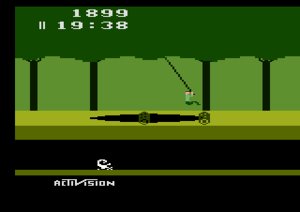 like jungle. You have to avoid different hazards along the way, which included tar pits, quicksand, rolling logs, snakes, scorpions, walls, fire, and crocodiles. To avoid these obstacles the character would have to jump and climb, and in certain places he can swing on a vine to avoid them.
like jungle. You have to avoid different hazards along the way, which included tar pits, quicksand, rolling logs, snakes, scorpions, walls, fire, and crocodiles. To avoid these obstacles the character would have to jump and climb, and in certain places he can swing on a vine to avoid them.--------------------------------------------------------------
The games that I have looked at for the Neo Geo are Ryuko no Ken (Art of Fighting), Gekka no Kenshi (The last Blade), Metal Slug: Super Vehicle SU-001 and Puzzle Bobble.
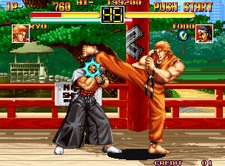 Art of Fighting is a fighting game series which was created by SNK. When released it was one of the first fighting games to include a super bar, it also introduced the spirt gauge and the desperation move. This game had its own sequels of 2 and 3 and it led it a huge amount of spin off games. Some of these include:
Art of Fighting is a fighting game series which was created by SNK. When released it was one of the first fighting games to include a super bar, it also introduced the spirt gauge and the desperation move. This game had its own sequels of 2 and 3 and it led it a huge amount of spin off games. Some of these include:The King of Fighters series
Capcom Vs SNK series
Fatal Fury
Neo Geo Battle Coliseum
The last Blade is another fighting game that was created by SNK. The game takes place during the Bakumatsu era of Japan and also included Japanese mythology. The game was characterised by two selectable fighting stances, and a unique combo system. It also used a deflect and parrying system. The Last Blade also had sequels that included:
The Last Blade 2: Bakumatsu Rouman Dai Ni Maku: Gekka No Kenshi Tsuki Ni Saku Hana, Chin Yuku Hana.
The Last Blade – Beyond the Destiny
Metal Slug is a scrolling shooter computer game created by SNK and released in 1996. The game required the player to constantly shoot at re-spawning enemies in order to reach the end of the level; here you would meet the end of level boss.
Puzzle Bobble is a puzzle game series created by Taito. The idea of the game was to match up different coloured balls using a fixed cannon, whose angle could be changed, to fire the coloured balls at a pre arranged pattern at the top of the screen. If the ball manages to come into contact with identically coloured balls and forms a group of three or more, those balls and any hanging from them are removed. Points are rewarded depending on how many ball are removed from the screen at once.
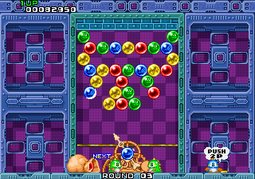
----------------------------------------------------
From the research I have carried out and the different number of games that I have played for this blog; these are my feelings toward early games design in Europe/America and Japan. The Games from Europe/America, I feel are all a bit samey. Many of them involve mindless shooting at objects to get to the next part of the game. Of course not all the games were like this, I have written about two who you could say kicked off there own genres. The Japanese games I feel were also trying something new when they come up with an idea for a game. (Although this game could then spawn off many sequels and spin off games as I showed with Art of Fighting. I feel that while European/American designers were churning out another shooter, Japanese designers were coming up with new puzzles games and bright and colour games. The main reason I feel for this the difference in what gamers wanted from each continent, and this is still apparent today in the gaming charts.
Having looked at the latest games charts on:
http://www.gamesindustry.biz/charts.php
From these latest charts you can see the difference in the games that people play in different countries. In Japan you can see that the games they play are puzzle game and RPGs such as Brain age and English Training DS. As for the American and UK charts, they are full of shooters and sports games. I feel that this is one of the main reasons why early game design was different because they were making games for different people who wanted to play different things.
